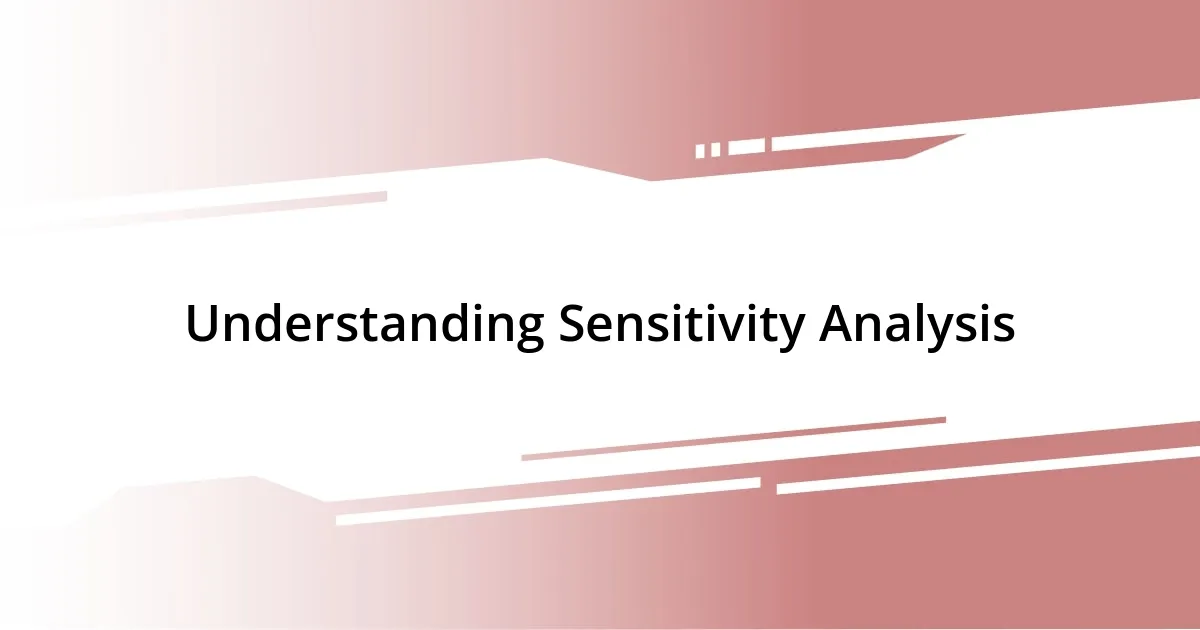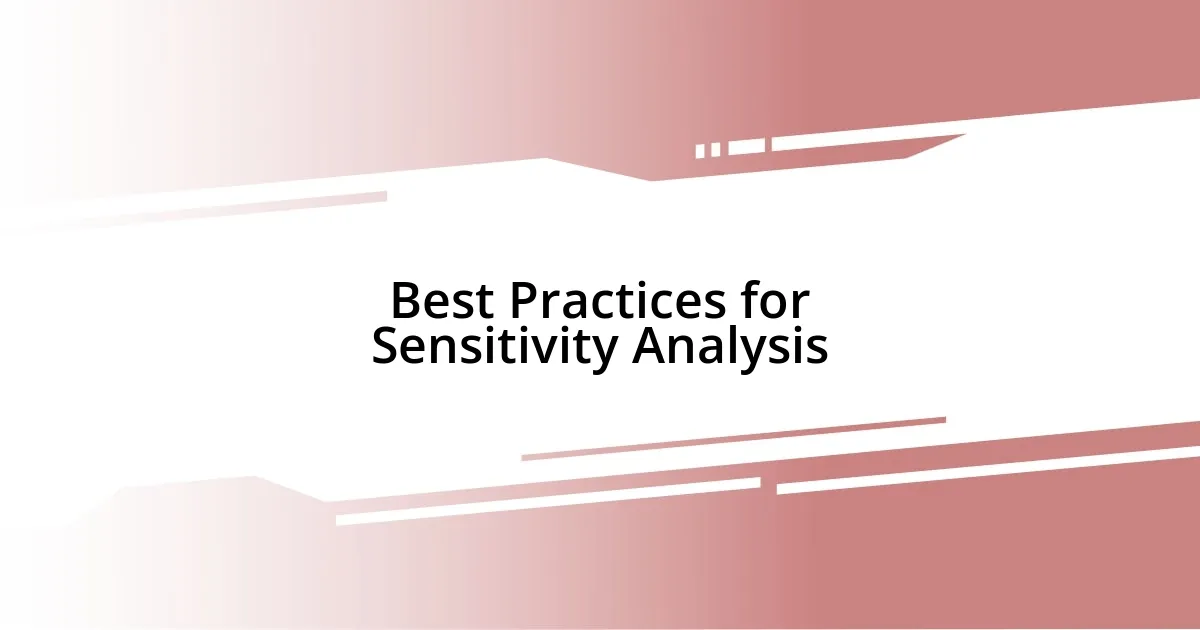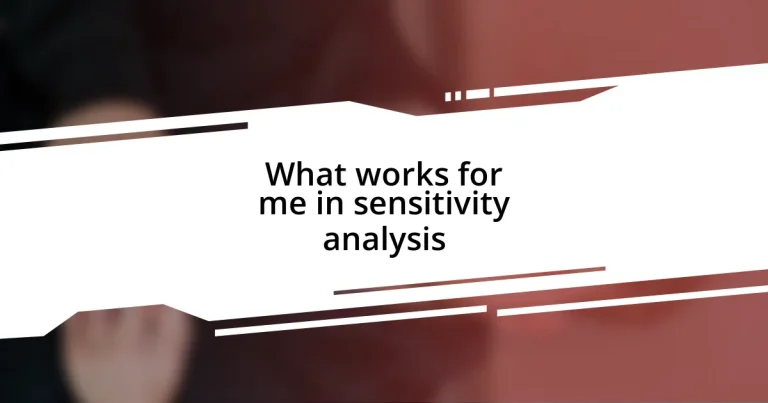Key takeaways:
- Sensitivity analysis enhances understanding of how input changes affect outcomes, providing valuable insights and prompting deeper discussions.
- Best practices include starting with a well-structured model, conducting one-at-a-time analyses, and utilizing data visualization to clarify results.
- Common mistakes comprise neglecting variable interactions, failing to define analysis scope, and over-relying on historical data without considering future scenarios.
- Tools like spreadsheet models and Monte Carlo simulations facilitate effective analysis by enabling quick adjustments and visual representations of potential outcomes.

Understanding Sensitivity Analysis
Sensitivity analysis is a powerful tool that allows us to understand how changes in input variables can affect outcomes in complex models. I remember the first time I conducted an analysis for a financial forecast; it was almost like peeling back layers of an onion. Each adjustment revealed something new about the model, sparking excitement and a deeper understanding of the underlying relationships.
When I dig into sensitivity analysis, I often find myself thinking, “What if?” This curious mindset transforms the process into an engaging dialogue with the data. By systematically altering variables and observing the ripple effects, I get to see not just the potential outcomes but also the robustness of my assumptions. Have you ever wondered how sensitive your model is to slight changes? It’s a question that leads to valuable insights.
For me, sensitivity analysis is not just about numbers; it’s about stories that the data tell. Every variable has its narrative, and adjusting one can shift the entire story’s direction. It’s similar to how a small change in a recipe can dramatically alter a dish—so why not apply that thought process to your analyses? That realization has profoundly impacted how I approach any modeling task.

Importance of Sensitivity Analysis
When I reflect on the importance of sensitivity analysis, it’s clear to me that it offers a safety net in uncertain scenarios. I remember a project where stakeholder decisions hinged on the projected outcomes of a new marketing strategy. By thoroughly analyzing how different assumptions influenced the forecast, I could reassure the team that we had a solid foundation, regardless of the twists the market might take. It provided peace of mind and ignited discussions about contingency planning that we otherwise might not have had.
- Transparency in Decision-Making: Sensitivity analysis shines a light on the relationships between inputs and outputs, allowing us to communicate uncertainty effectively.
- Robustness Evaluation: It helps us evaluate whether our conclusions hold merit or if they are overly dependent on specific assumptions.
- Risk Management: Through identifying critical variables, we can prioritize resources and focus on what truly drives performance, which is invaluable in times of uncertainty.
I’ve also experienced firsthand how sensitivity analysis can guide strategic pivots. I once worked on an investment analysis and discovered that small shifts in market conditions could drastically change projected returns. This revelation was eye-opening; it helped prioritize where to allocate resources and influenced a more adaptive approach, ultimately leading to a successful investment decision.

Best Practices for Sensitivity Analysis
Best practices in sensitivity analysis revolve around systematic experimentation and robust communication. One crucial practice I’ve adopted is the importance of starting with a well-structured model. When I first tackled a complex project, I spent hours optimizing my model’s framework. This upfront investment saved me countless hours during the analysis phase, ensuring that my inputs were accurate and my variables well-defined. Have you ever tried to untangle a messy knot? That’s how it feels when you’re working with poorly defined models—it can turn a straightforward analysis into a frustrating ordeal.
Another technique I swear by is conducting a one-at-a-time analysis. This is where you change only one variable at a time while keeping others constant. I remember using this method for a budget forecast, and it was enlightening. By isolating each factor, I could pinpoint which elements had the most significant impact on the outcomes. It was like holding a magnifying glass over my data—each variable began to speak its truth. This approach provides clearer insights and minimizes confusion.
Lastly, visualizing results can’t be overlooked. I often turn to charts or graphs to represent sensitivity analysis outcomes visually. On one occasion, using color-coded graphs helped my team immediately grasp the critical variables affecting our forecasts. The visual impact of those graphs sparked deeper conversations and innovative solutions. I’ve learned that a picture really is worth a thousand words. Have you ever noticed how visuals can transform complex data into accessible insights? It’s a game-changer in discussions and decision-making.
| Best Practices | Description |
|---|---|
| Structured Model Development | Starting with a well-defined model to avoid complications later. |
| One-at-a-Time Analysis | Changing one variable at a time for clearer insights on impacts. |
| Data Visualization | Using charts/graphs to convey findings effectively and spark discussions. |

Tools for Effective Sensitivity Analysis
In the realm of sensitivity analysis, tools can really make a difference. I once experimented with a spreadsheet modeling tool that transformed how I approached scenarios. It was incredible to see how quickly I could adjust different variables and immediately observe the potential impacts. Have you ever felt that thrill when a simple change unveils layers of insight? That tool did exactly that for me.
Another resource I heavily rely on is Monte Carlo simulations. The first time I dove into a Monte Carlo analysis, I was struck by the complexity and elegance of the results. It allowed me to understand the probabilities of various outcomes, not just single-point estimates. Picture this: it’s like standing in a storm and watching how each raindrop dances differently as it hits the ground. Each simulation reveals a new path, illuminating uncertainties and helping me plan accordingly. It’s a fascinating blend of mathematics and intuition that I highly recommend.
Finally, I’ve found great value in software like Crystal Ball and @RISK. While learning to use these programs initially felt like stepping into a foreign land, I quickly uncovered their potential to visually depict how different scenarios play out. One memorable project involved assessing product viability in fluctuating markets, and these tools enabled me to present findings to stakeholders with confidence. Do you remember the sense of empowerment that comes from having a well-equipped toolkit? That feeling is what I strive for in every analysis, knowing I can explore various outcomes with assurance.

Common Mistakes in Sensitivity Analysis
A frequent pitfall I’ve encountered in sensitivity analysis is neglecting the importance of variable interactions. Early in my journey, I focused solely on individual variables without considering how they affected one another. This oversight led to some misleading conclusions, leaving me scratching my head. Have you ever realized too late that what you thought was true was only part of the story? Recognizing these interactions can significantly alter outcomes, highlighting the need for a comprehensive approach.
Another common mistake I’ve observed is failing to define the scope of analysis clearly. In the past, I jumped into analysis without setting boundaries, and it resulted in an overwhelming amount of data that was impossible to navigate. Think about it: without a clear focus, how can you expect to extract meaningful insights? Now, I make it a point to establish and communicate the parameters of my analysis upfront, which keeps my efforts streamlined and relevant.
Lastly, relying solely on historical data can be a trap. I remember a time when I depended heavily on past performance metrics for forecasts. Initially, it felt like a safe bet, but the dynamic nature of markets quickly revealed its limitations. Have you ever clung to old data only to find it leading you astray? Balancing historical data with forward-looking scenarios has become essential in my analysis, allowing me to better anticipate changes and respond to uncertainties.














